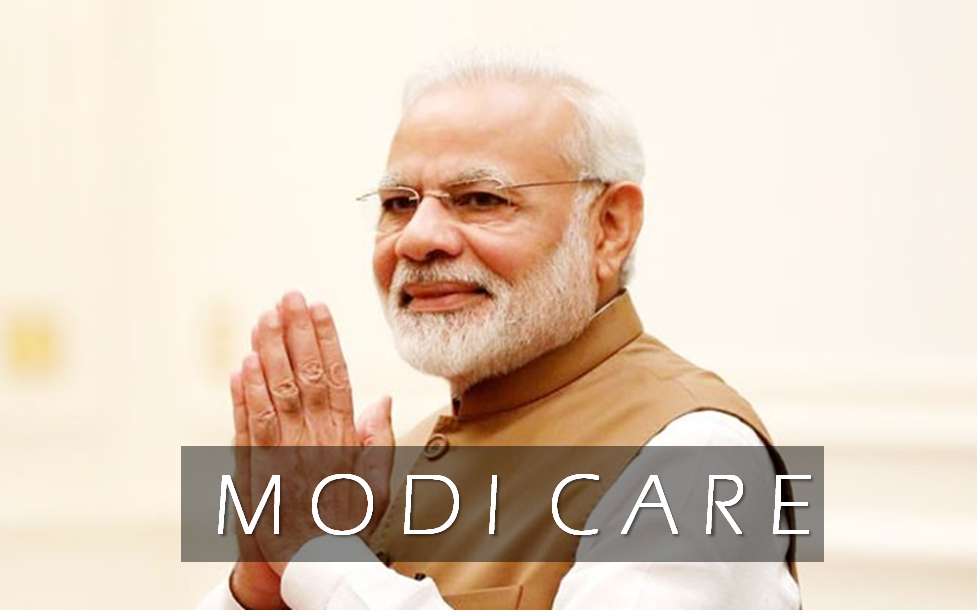The next emerging superpower, the next global leader, the youngest working population, the nation on an economic tipping point, and countless other phrases have been used in the last few years to define our nation. With a projected growth in literate Indians, and over 800mn internet users, the challenge lies in harnessing the potential encompassed within these numbers. The Modi government, if alien to a few aspects of our socio-economic ecosystem, is not alien to this one, for it acknowledges the fact that a healthy nation can only be created in the backdrop of a healthy population. This is where Modicare – PM Modi’s ambitious health care plan comes into play. With an aim to cover 10-Crore families, or approximately 50-Crore beneficiaries, the objective is magnanimous in its objective.
A mere visit to any public hospital, even to the likes of PGIMER or AIIMS, is enough to understand the destitution that shackles our healthcare system. The lack of doctors, attendants, and facilities are a major barrier to a thriving healthcare system in India. Private entities in the realm of medicine have been out of bounds for most middle-class Indians, forget the rural ones, and hence, the burden fell on public hospitals, which somehow have survived the excruciating imbalance of supply and demand.
Modicare, as we name the plan from here, is not a populist measure, as some would like us to believe, given we are months away from the National Elections. It was long in the making, from the first year of the Modi government itself.
Financial Inclusion via bank accounts today ensures that the insurance cover can be arranged, verified, and implemented without any bottlenecks. Aadhar enabled identification system ensures that the beneficiaries are reached out at the earliest, and there are no leakages within the monetary allocation system. With digital literacy and internet connections, the rural population shall be able to access and plan their healthcare needs in the long run, and given the projected addition of 500mn Smartphone users by 2025, digital literacy is not going to be a luxury, but the norm.
Modicare has received quite some flak, but the fate of PM Modi is such that even if he were to carpet bomb the headquarters of Hafiz Saeed tomorrow, he would be criticized for being reckless and intolerant. Firstly, the fiscal burden has been put in question, for the plan would require money to be sustained. However, little do critics realise that the fiscal burden is not always about the money spent, but also about the money that could have been earned, created, or pushed into the economy had the population not been plagued with diseases. Yes, money is going to be spent to implement this plan, but money is also being lost annually due to diseases, especially the non-communicable ones, given they are not detected unless the problem becomes incurable or irreversible.
Tomorrow, hypothetically, even if we were to employ 100-persons for a job, all above 18, able in skill, we wouldn’t be able to draw maximum productivity from them, given the nourishment, stunting, and countless other issues that plague the rural population of India. Alongside, this is where Aadhar comes into play significantly. With a secure system in place, Aadhaar must facilitate a medical record of some kind, accessible only to the beneficiary and the hospital they are being treated in. Having a sequence of medical records for a local community, town, district, state, and so on could help the government with its budget allocations, schemes, and programmes pertaining to public health. Last, but no way the least, Aadhaar can eliminate monetary leakages, as numerous case studies have showcased.
Secondly, the coverage of Modicare has been deemed as non-feasible, for the targeted population is 1.6 times that of the entire US population in number. However, going by this logic, India can never implement or execute a policy for the collective good and must confine itself to the conventional methodologies of solving problems and overcoming challenges. Yes, the earlier stages of the plan could face issues pertaining to coverage, but over a period of time, one can expect the data to be the catalyst in the coverage process. Data creates data, and this one aspect could fuel the growth of the Modicare plan in the long run.
Healthcare facilities are in a need of an urgent upgrade across various spectrums, ranging from infrastructure to logistics. Private entities need to up the ante, assist practitioners, curate skill development programmes pertaining to medicine that can help combat a non-communicable disease in its nascent stages, and so on. The government must step in to ensure that private enterprises do not use this insurance coverage as a cloak for their business models, and impart treatment in a precise manner. Healthcare must amount to curating a disease, creating a healthy body, and should not only be about profits, as some private entities have made us believe. If the variables of this equation are solved together correctly, one could solve the problem of unemployment, lack of practitioners, and rural healthcare to a certain extent.
Needless to say, the road for Modicare is going to be a bumpy one, but thankfully, some major concerns have already been addressed by financial inclusion and Aadhar. To dumb it down to a common ideology, the stage has been set for the last-20 overs after a fitting run-a-ball score in the first-30 overs without the loss of a wicket. Combating leakages, identify thefts, data security and privacy are already being worked on, and within this ecosystem, the Modicare can and must be made to succeed, for it was long in the making.
